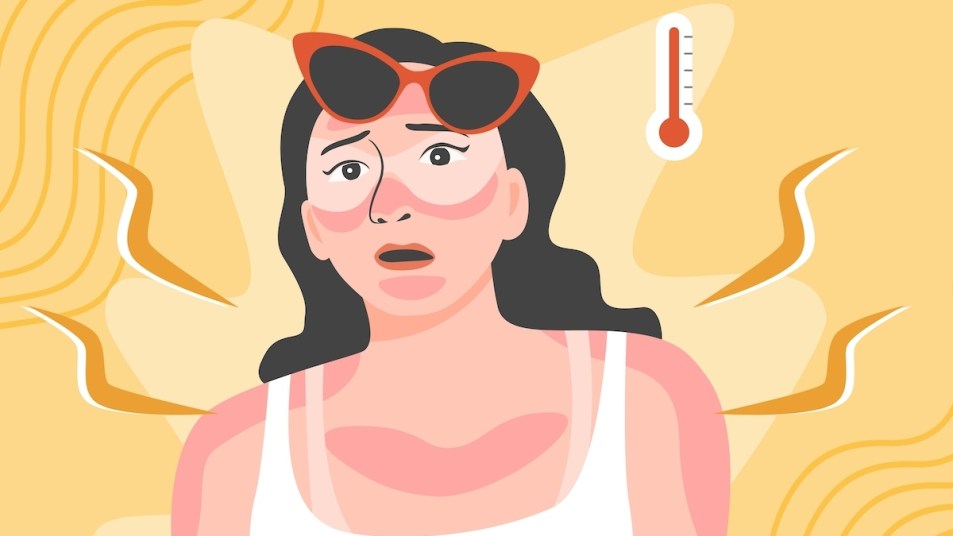Red in the Face? Here’s How To Heal a Sunburn Fast
From using aloe vera to taking cold showers, these tips will help soothe your skin.

Sunburns happen, often when we’re not even paying attention and even on cool, cloudy, or overcast days. Painful as they may be and unapeel-ing — pun intended — as they may look, their real harm is far more concerning. Repeated sun exposure and sun damage like burns can dramatically increase your risk of skin cancers. That’s why, whether you’re vacationing in the tropics or planting a backyard garden, you should always be mindful when spending time in the sun. If you do get sunburned, here’s how to support the healing process and find fast relief from pain.
How do you get rid of a sunburn?
How to heal your sunburn depends on its severity. For example, a second-degree burn will be less responsive to home remedies than a slight flush. Here are methods for managing sunburn symptoms and healing from excessive sun exposure.
Use aloe vera gel.
Aloe vera is a common and effective tool for treating sunburns fast and at home. In nature, aloe comes from a plant similar to a cactus that grows in hot and dry climates. When you peel back the exterior skin of the aloe plant, you’ll find a soothing, gel-like substance. Consider it nature’s vaseline.
This substance doesn’t “treat” sunburns (because there is no cure), but it does provide instant relief for pain, heat, and skin irritation. Plus, the gel has been shown to reduce inflammation (which is the puffiness and swelling you may feel during a sunburn) and expedite the process of regenerating skin cells. Aloe vera may be a bit sticky, but the relief is more than worth it.
Drink a lot of water.
It’s important to drink water both when you’re in the sun — particularly on very hot days — and when you’re healing from a sunburn. Doing so will replenish your body and mitigate some of the effects of sun exposure, like heat exhaustion.
Take cool baths or showers.
The blood vessels below the surface of your skin react to the environment and conditions around you. When exposed to hot temperatures, like a very hot shower, they actually get wider. That means more blood is flowing to the surface of your skin, which means you’ll feel your sunburn much more painfully. Cold showers and baths won’t heal your sunburn, but they can provide temporary relief after exposure.
Moisturize.
After you’ve taken a cool shower or bath, grab your favorite moisturizer, ideally one with aloe vera or another soothing ingredient like soy. Before you dry your skin all the way, gently rub the moisturizer over the areas with sunburn. This will trap the water close to the skin, allowing the skin to hydrate and mitigating the worst side effects of your sunburn.
Take anti-inflammatories.
Over-the-counter anti-inflammatory medications, like ibuprofen or acetaminophen, are pain relievers that can help reduce the pain associated with your sunburn symptoms. That’s because inflammation and sunburns go hand-in-hand. When the skin absorbs too much ultraviolet light, it can kill the cells, triggering an immune response in the skin. Between the dead cells, the increase in blood flow, and the immune response to environmental conditions, the skin becomes inflamed. This inflammation is what we know as sunburn — which explains why anti-inflammatory medications like Tylenol and Advil can help.
Let your skin breathe.
It’s important to keep your skin uncovered or gently covered. Rough or tight materials can be extremely painful to wear over a sunburn and may even interfere with the healing process. That’s because your body is essentially creating new, healthy blood cells, and it needs nutrients to do so. Proper circulation is required to effectively build these new blood cells and help heal your skin, so you’ll want to skip any restrictive clothing that might affect that circulation.
Avoid further stress.
Side effects that often accompany sunburns include peeling skin and blistering. Mostly, these are fairly harmless and will eventually go away on their own. You want to allow the skin to fall off naturally rather than pulling at it, as this can further irritate the healing sunburn and affect the healing process. When it comes to sun blisters, do your best to leave them alone. Popping these blisters can be painful and can make your body more vulnerable to infection.
Protect your skin in the future.
Sun exposure and sun damage can compound over time and may have significant and lasting health impacts, including skin cancer. That’s why it’s important to protect your skin against exposure and further damage every time you go outdoors. Any good board-certified dermatologist would recommend integrating a high-SPF sunscreen moisturizer into your skincare routine (think: SPF 30 or above) or wearing clothing that protects against UV rays. Hats and umbrellas are also effective ways to reduce your long-term risk.
Protect and Heal Your Skin
Whether you’re taking the boat out or enjoying a day at the park, sunburns are always a risk. Precautions can be effective, but what do you do if you get burned? Skincare is healthcare, whether it comes in the form of eating more antioxidants, taking an exfoliating colloidal oatmeal bath, or protecting your skin from the sun using our tips above.
The good news is that relief is available, and you might already have the supplies needed to provide it. Products like aloe vera and moisturizers are useful, and simple actions, like taking cool showers and drinking enough water can help. Additionally, select over-the-counter meds can relieve sunburn and inflammation.












